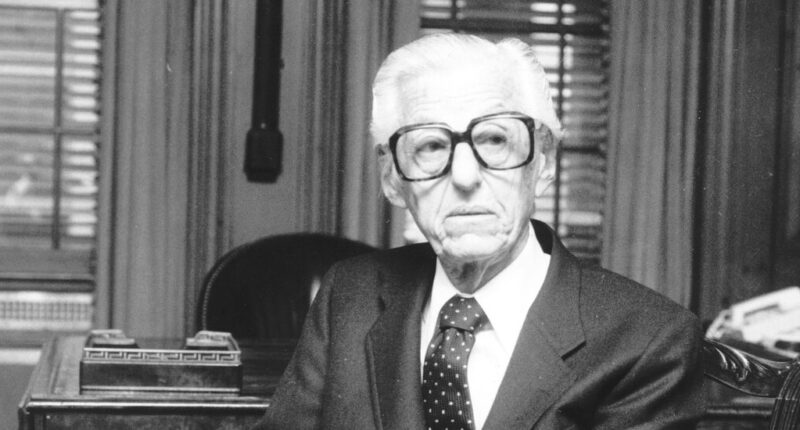
The 1954 Hollywood classic “On the Waterfront” ends with unionized longshoremen on a dock. They’re fed up and standing idle, staring at a bloodied Marlon Brando. All of a sudden, an authoritative man in a fancy suit and a natty hat arrives. “We gotta get this ship going,” he barks. “It’s costing us money!”
Over the last week, as TV and movie actors went on strike for the first time in 43 years, joining already striking screenwriters on picket lines, Hollywood started looking around for its version of that figure — someone, anyone, to find a solution to the standoff and get America’s motion picture factories running again.
But the more the entertainment industry looked, the more it became clear that such a person may no longer exist.
“Back in the day, it was Lew Wasserman who would enter the talks and move them along,” said Jason E. Squire, professor emeritus at the University of Southern California’s School of Cinematic Arts, referring to the superagent turned studio mogul. “Today, it is different. Traditional studios and the technology companies that have moved into Hollywood have different cultures and business models. There is no studio elder, respected by both sides, to help broker a deal.”
At the moment, no talks between union leaders and the involved companies are happening and none have been scheduled, with each side insisting the other has to make the first move.
Two federal mediators have been studying the issues that led to the breakdown in negotiations. Agents and lawyers are engaged in a flurry of back-channel phone conversations, encouraging union leaders and studio executives to soften their unmovable positions; Bryan Lourd, the Creative Artists Agency heavyweight, asked the Biden administration and Gov. Gavin Newsom of California to get involved, according to three people briefed on the matter, who spoke on condition of anonymity because of the sensitivity of the labor situation. A spokesman for Mr. Lourd declined to comment.
Emotions must cool before talks restart, said one entertainment lawyer who has been working in the background to bring the sides together again. When does that happen? He said it could be next week or it could be-mid August.
Starting in 1960, the last time both actors and writers were on strike, and continuing into the 1990s, the person who could break an impasse was the feared Wasserman. He commanded the respect of both labor and management and could push beyond the colorful personalities in each camp.
It was an era when the entertainment business, for the most part, was much less complicated. Studios had not become buried inside conglomerates and beholden to lucrative toy divisions, not to mention having to deliver quarterly growth.
Bob Daly, who ran Warner Bros. in the 1980s and ’90s, picked up the mantle from Wasserman, who died in 2002. Mr. Daly, who went on to run the Los Angeles Dodgers, said by phone that he was no longer involved in Hollywood’s labor strife. But he had some advice.
“One thing that has troubled me is that it has become personal, which I think is a mistake,” Mr. Daly said. “The only way this is going to get solved is for both sides to get in a room and talk, talk, talk until they find compromises. Neither side is going to get everything it wants. You can yell and scream inside that room — I did myself many times — but don’t come out until you have a deal.”
The last Hollywood strike took place in 2007 and 2008. The Writers Guild of America walked out over a variety of issues, with compensation for shows distributed online a major sticking point. It was resolved after 100 days (the current writers’ strike was 81 days old on Thursday) when Peter Chernin, then president of News Corporation, and Robert A. Iger, Disney’s relatively new chief executive at the time, took a hands-on role in solving the stalemate. Barry M. Meyer, who was chairman of Warner Bros., and Jeffrey Katzenberg, then the chief executive of DreamWorks Animation, also played roles.
All those men, with the possible exception of Mr. Chernin, are now busy with other matters or viewed as villains by actors.
Mr. Iger, who returned to run Disney in November after a brief retirement, became a picket line piñata last week after telling CNBC that, while he respected “their right and their desire to get as much as they possibly can,” union leaders were not being “realistic.” The backdrop of his interview, a meeting of elite media and technology executives in Sun Valley, Idaho, poured gasoline on the moment.
Mr. Katzenberg largely left the entertainment business in 2020 after the collapse of Quibi, his streaming start-up. In April, Mr. Katzenberg was named a co-chair of President Biden’s re-election campaign.
Mr. Meyer retired from Hollywood in 2013 after a celebrated 42 years and went on to sit on the board of the Federal Reserve Bank of San Francisco. “I’ve had nothing to do with the negotiations this year,” he said in an email. “That being said, it doesn’t stop me from feeling sad about the way things are stuck right now.”
That leaves Mr. Chernin. He left Hollywood’s corporate ranks in 2009 and founded an independent company that includes a film and television production arm — he has a deal with Netflix — and a sprawling investment portfolio focused on new technology and media companies. In recent days, Mr. Chernin told one senior associate that he had not been approached for help in the strikes, but that he would be hard-pressed to say no if asked.
A spokeswoman for Mr. Chernin declined to comment.
The studios that now must figure out how to appease actors and writers are wildly different in size and have diverging priorities. They all say they want to resolve the strikes. But some are more willing than others to compromise and immediately restart talks. The willing camp includes WarnerBros. Discovery, while Disney, which owns Disney+ and Hulu, has taken a harder line, according to two people involved in the negotiations. WarnerBros. Discovery and Disney declined to comment.
Some people in Hollywood have been looking to elected officials to help smooth a path, but so far direct involvement, if any, has been unclear. The mayor of Los Angeles, Karen Bass, last week called the actors’ strike “an urgent issue that must be resolved, and I will be working to make that happen.” A spokesman did not respond to queries about what she was specifically doing.
Mr. Newsom said in May that he would intervene in the writers’ strike “when called in by both sides.” He has not commented on the actors’ walkout, and a spokesman did not respond to queries.
With two unions on strike, it could be months before new contracts can be negotiated and ratified. The Alliance of Motion Picture and Television Producers, which negotiates on behalf of the biggest studios, has decided to first focus on resolving differences with SAG-AFTRA, as the actors’ union is known, according to the two people involved in the negotiations.
Cameras may not begin rolling again until January, given the time it takes to reassemble casts and crews, with the end-of-year holidays as a complication, executives at WarnerBros. Discovery and other companies told staff members this week.
SAG-AFTRA and the Writers Guild of America are striking largely because, they say, entertainment companies — led by Netflix — have adopted unfair compensation formulas for streaming. This was the biggest sticking point at the negotiating table, much more so than union demands for guardrails around artificial intelligence, according to three people briefed on the matter. (The companies defended their proposed improvements to the contract as “historic.”)
Under the now-expired contracts, streaming services pay residuals (a form of royalty) to actors and writers based on subscriber totals in the United States and Canada. The actors’ union, in particular, has made it clear that a new contract must go back to a version of the old way — with streaming services using pay formulas that are based on the popularity of shows and movies, the way traditional television channels have done for decades, with Nielsen as an independent measuring stick.
Streaming companies refuse to divulge granular viewership data; secrecy is part of Big Tech’s culture. Independent measuring companies, including Nielsen, have tried to fill the gap, but they have provided only vague information — what is generating a lot of views, what is not. Nobody except the companies knows if a streaming show like “Stranger Things” is watched by 100 million people worldwide or 50 million.
Netflix signaled on Wednesday that it saw the data it discloses as sufficient. The company posts weekly top-10 lists on its site; the rankings are based on “engagement,” which Netflix defines as total hours viewed divided by run time.
“We believe sharing this engagement data on a regular basis helps talent and the broader industry understand what success looks like on Netflix — and we hope that other streamers become more transparent about engagement on their services over time,” Netflix said in its quarterly letter to shareholders.
John Koblin contributed reporting from New York.
Source: | This article originally belongs to Nytimes.com








